Guest contributor: Joaquín Abal, vice president, DILA Capital
Anyone who has remotely followed the LatAm venture ecosystem lately has surely noted that market dynamics have changed significantly in the last six to twelve months. A key factor driving this change is the sudden influx of international investors into the LatAm arena.
According to Crunchbase, out of the last 152 early deals recorded between January and July of the current year, 63% involved an international or global fund (non-LatAm based). A further breakdown indicates that out of that number, 17% were at a pre-seed stage, 62% at a seed stage and 21% at a Series A or B stage.
From the group of deals that involved international funds, co-investment with local or domestic funds represented 65%, consortiums of international investors without a local partner accounted for 25%, and the remaining 10% was primarily companies with a large share of international investors and YC-backed investments.
It’s apparent that global funds still find value in co-investing with local investors; however, the percentage of transactions involving only international investors is quite significant. Most of these co-invested transactions have been led by the international side, resulting in larger rounds, higher valuations, and smaller allocations for local funds. Given their smaller fund sizes, domestic investors could find it increasingly difficult to play this signalling game effectively and still deliver above-average returns to their LPs.
While the presence of this prominent new actor is altogether good news for (disciplined) founders, it’s partially good news for local and regional investors.
Collaboration is spiking, but so is competition. Only now competition has stepped up: strong brands backed by solid track records, lifecycle capital, a powerful signalling effect, and a cutting-edge perspective enabled by the continuous exposure to the most innovative, “0-1” founders.
Leading and non-leading local funds across different LatAm markets will need to reassess their investment strategy to stay on top of this trend. This review needs to be deeply rooted in their proximity and knowledge of LatAm founder’s needs, as well as on a thorough understanding of their own competitive advantage within the ecosystem.
What are local funds bringing to the table?
I recently talked to a company’s founder after it raised one of the largest seed rounds in the history of the LatAm ecosystem from top-tier international funds. He admitted to me that Mexico was an extremely complex landscape to navigate and that he needed to add some “local flavour” to his cap table urgently.
Once a funding round is closed, founders need to execute. They need to validate their initial product with local customers, accelerate an enterprise sale, or surpass a regulatory hurdle with domestic authorities, as fast and efficiently as they can.
However, within each LatAm market, there’s that closed-loop, dense network dynamic, which makes it very hard to penetrate for most of the founders. This journey gets even harder as they look to regionalize their operations and step out of their home market.
This pain point is at the core of local investors’ value proposition. The term local flavour suggests the understanding of the market structure and key players across sectors and hierarchies at the most granular level, coupled with the ability to seamlessly reach out and influence the right stakeholder. Market dynamics might have changed, but the value of hyperlocal expertise and networks is still invaluable for founders.
There’s a softer role that domestic investors play as well, which was perfectly defined by an entrepreneur I recently encountered as the psychologist role. The ability to develop a close confidant relationship driven by cultural affinity is not to be understated when it comes to long-term, rollercoaster-type partnerships.
What should be expected moving forward?
Collaboration through co-investment will persist. It will be a gradual interrelation process, where each of the parties share and transfer capabilities, knowledge, and networks. However, as local expertise of international funds increases, it’s likely that reliance on domestic partners will decrease.
In this rapidly changing context, local funds will react differently: some will remain passive, others make minor changes and strengthen the fort, while some players will act decisively to reshape their capabilities and deliver a truly differentiated proposition to stay ahead.
In the latter part of the reaction scope, there’s an opportunity for prominent local funds to enhance their competitive hyperlocal edge, which could come from consolidation: a merger between leading domestic investors across different LatAm markets, and the creation of (another?) hyperlocal regional powerhouse.
A regional powerhouse is a top-of-mind investor that’s able to attract the best founders across stages, geographies, and sectors. It amasses heavy firepower to back entrepreneurs across their lifecycle and can attract other funds through a strong signalling effect.
Very few LatAm-native funds tick almost all the boxes of this definition. However, they still lack a central part of a comprehensive value proposition: hyperlocal expertise and network in each of the markets they operate in, in order to actively support both the local and regional scaling process of entrepreneurs.
In theory, a LatAm consolidation play involving local leading funds from different markets could bring together a very powerful proposition for founders with a regional ambition: a one-stop-shop with increased firepower and hyperlocal capabilities in every relevant LatAm market, enabling a faster and more efficient regional scaling process. T
his proposition tackles a founder’s core needs and clearly differentiates from the offering of an international fund.
Many of the leading local funds are expanding to the region organically and leveraging soft collaboration with domestic stakeholders from other markets. The effectiveness of this strategy remains to be seen; however, creating that kind of deeply rooted, local flavour that provides an edge might take years, decades, or perhaps is just not possible to replicate for an outsider.
The struggle to penetrate dense hyperlocal networks apply equally to both entrepreneurs and investors. No matter how they decide to navigate this fast-changing environment, local investors will need to act strategically and swiftly to maintain their position as market leaders, to perform averagely, or in some cases even to survive.






